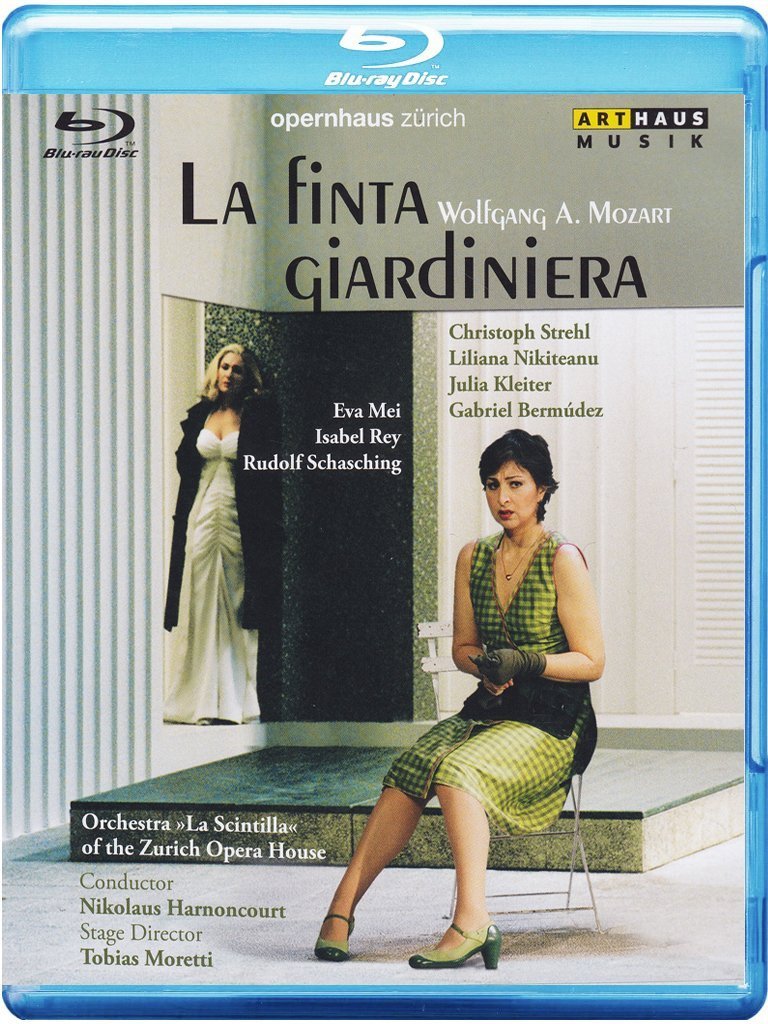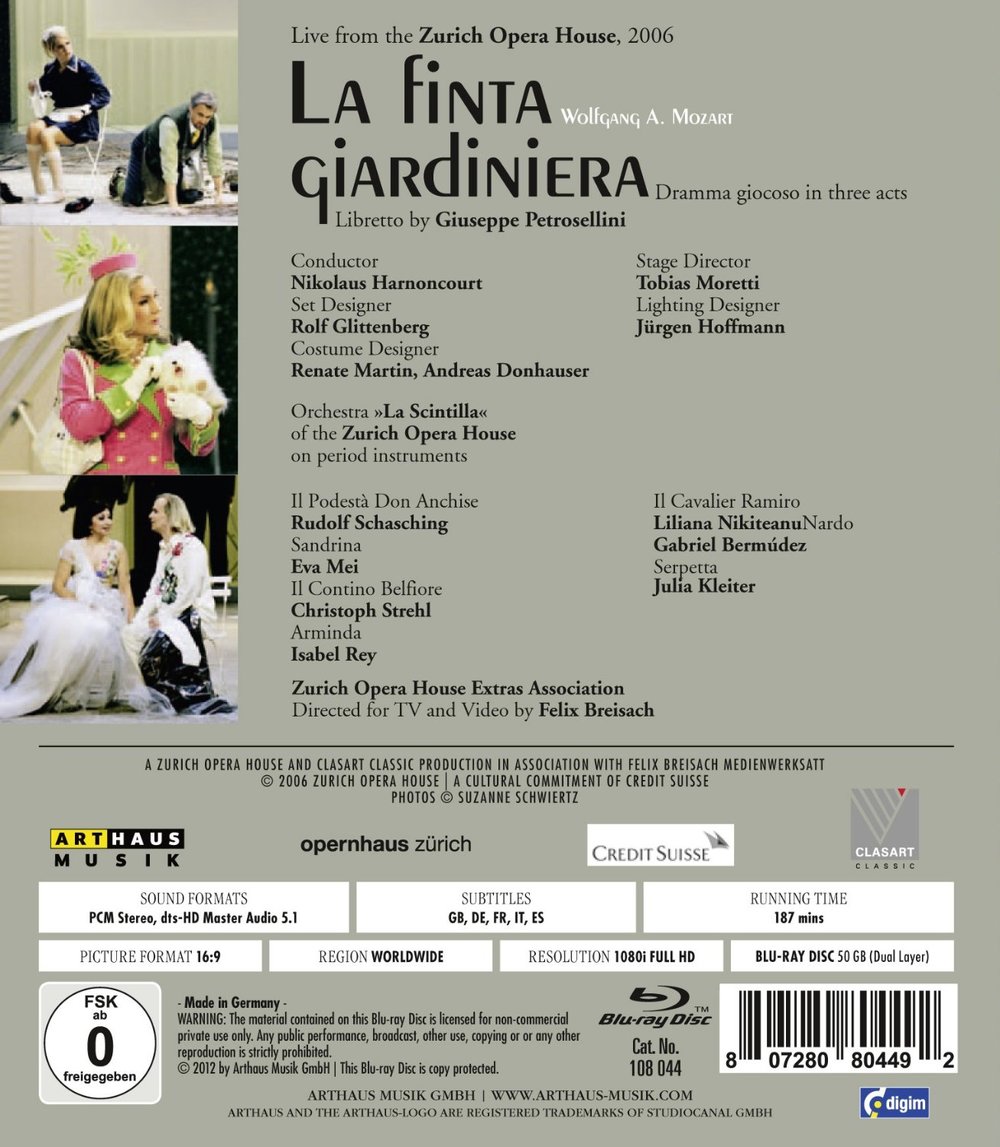

Mozart La finta giardiniera opera (composed at age 18) to a libretto possibly from Giuseppe Petrosellini. Directed by Tobias Moretti at Opernhaus Zürich in 2006. Stars Eva Mei (Sandrina), Christoph Strehl (Il Contino Belfiore), Rudolf Schasching (Il Podestà Don Anchise), Isabel Rey (Arminda), Liliana Nikiteanu (Il Cavalier Ramiro), Julia Kleiter (Serpetta), and Gabriel Bermúdez (Nardo). Nikolaus Harnoncourt directs the Orchestra "La Scintilla" of the Zurich Opera. There is no chorus. Set design by Rolf Glittenberg; costumes by Renate Martin and Andreas Donhauser; lighting by Jürgen Hoffmann. Directed for TV by Felix Breisach. Sung in Italian. Released 2009, disc has 5.1 dts-HD sound. Grade: A
This is the same title that was released in 2009 by TDK. TDK phased out of HDVD and the rights to their HD titles were taken up by others. You may be able to find a TDK version of this at a true bargain price.
This was performed maybe three times during Mozart's life and then lost for about 175 years until a manuscript was discovered in the 1970s. Although early rather than mature Mozart, it's a complete three-hour-long work with an intriguing opera buffa libretto to keep you on your toes, interesting characters, lots of laughs, and a steady parade of arias suffused with that limpid tenderness that distinguishes Mozart from all others.
There are 7 characters, and below we meet 5 of them, all claiming in a jaunty quintet to be happy . But we can see from their faces that all of them are in misery. Let's find out why! On your right is Don Anchise (Rudolf Schasching) the mayor or Podestà of the town:
Below we see that the Podestà is desperately in love with Sandrina (Eva Mei), dressed in green, even thought Sandrina works in the household as a humble garden girl. The Podestà, who is willing to marry down for true love, doesn't know that Sandrina is a phony garden girl (the "finta giardiniera"). She is really Countess Violante Onesti. The Countess had a terrible fight with her boyfriend, who tried to kill her in a fit of madness and then fled. So she is now living undercover as she tries to find her departed lover. (Why doesn't the Podestà recognize the Countess? Why does Sandrina want to find the boyfriend? Why does taking a fake identity help the cause? My friends, this is opera buffa!)
The maid is Serpetta (Julia Kleiter), a classic opera buffa sassy servant. You can see she has the hots for the Podestà and hopes to marry up. The gent below in green is Nardo (Gabriel Bermúdez), a servant of Countess Violante, who pretends to be a gardener and cousin of Sandrina. He is in love with Serpetta, which would be appropriate. But Serpetta has her sights set high and studiously ignores Nardo:
The man with the earphones and red jacket is the knight Ramiro (Liliana Nikiteanu in pants), a poet and philosopher. He was dumped by a mysterious woman and now nurses a broken heart:
There are 54 recitatives and singing numbers in this opera, so everybody will get to pour out his heart multiple times. Here Sandrina bemoans the plight of all women:
Now we meet our remaining two characters. The Podestà, who is middle class, has a niece, also middle class but wealthy, named Arminda (Isabel Rey). Arminda arrives at the Podestà's villa to marry a man the Podestà has found for her, a certain Count Belfiore:
Count Belfiore (Christoph Strehl), well-connected but desperate for money, arrives to meet his bride. Director Moretti and Strehl treat us to perhaps the funniest physical comedy ever published in an opera HDVD. Among many gags that would make Rowan Atkinson (Mr. Bean) envious, we see the impoverished Count kiss the maid by accident and sit on a cactus:
But best of all we witness an utterly hilarious recitation by the Count providing proof of his "ancient nobility." Here the Count has worked his genealogy back to Roman heroes:
You probably already figured this out, but now we learn that the Count is Sandrina's vanished boyfriend. When Sandrina hears the name Belfiore, she faints. The Count is called to her aid and is astonished to encounter a servant girl who looks just like the Countess Violante Onesti that he abandoned:
And Arminda turns out to be the very woman who dumped the knight Ramiro! So now we have 7 lovers, each chasing a wrong or inappropriate person:
Arminda is baffled:
Serpetta plays a game with Nardo. In a funny scene, Nardo tries in vain to win over Serpetta in Italian, French, and English:
Count Belfiori is still uncertain who Sandrina is. He agrees to marry Arminda:
But suddenly an arrest warrant turns up for Belfiori, who is accused of murdering a certain Countess Violante Onesti:
Sandrina testifies at the hearing that she is really Countess Violante Onesti, alive and well, and that Belfiori is innocent of murder:
But after the warrant is refused, Sandrina changes her story again!
Clearly, the Count must suffer greatly before Violante will forgive him. But no matter how confusing things appear to be, a man of the Enlightenment still has his reason:
Arminda and Sepetta join forces to get rid of Sandrina by having her abducted and abandoned in a forest:
While the others search for Sandrina, Serpetta gets a chance to expound her philosophy:
A wild search for Sandrina in the forest results in opera's only known double ma—ad scene:
But this is Mozart, so eventually loves wins out:
This duet is made in part sung directly to the audience:
The other pairs of lovers realign until everybody has a mate from his own social class. Ramiro gets the jilted Arminda. Serpetta decides that Nardo is worth another look. The Count and Countess hook up, and the poor Podestà has to run an ad for a new garden girl:
The libretto to La finta is stilted and repetitive as Violante and Belfiori play "She loves me, she loves me not" with a daisy sporting 54 pedals. But for every situation, Mozart comes up with charming music which leads to a good outcome for all while director Tobias Moretti delivers plenty of laughs. The singers all look right for their roles, and all of them can sing and act. The slightly odd-ball sets and contumes fit the goofiness at hand. The sound recording is fine, and Felix Breisach directs a superb video, especially for something filmed in 2006. There are Italian subtitles along with other languages. The arias have l—lots of repeats—I watch in English first and then switch over to Italian for a mini language lesson.
Mozart wrote eight full operas. Here's the list (with Mozart's age when he wrote each one): La finta giardiniera (18), Idomeneo, re di Creta (25), Die Entführung aus dem Serail (26), Le nozze di Figaro (30), Don Giovanni (31), Così fan tutte (34), La clemenza di Tito (35), and Die Zauberflöte (36). If you want to be properly acquainted with the Mozart opera canon, this La finta from Tobias Moretti is the place to start.




























